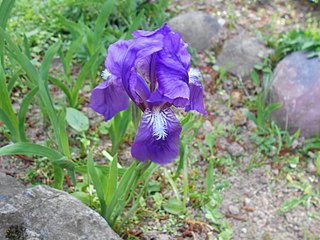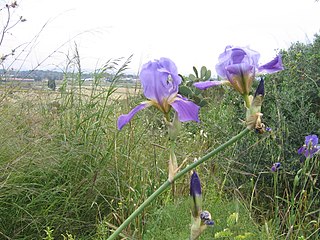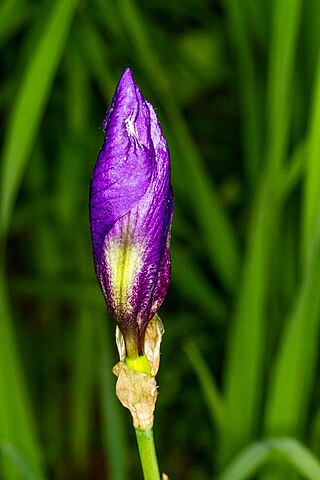
Iris croatica is a bearded rhizomatous species of iris endemic to Croatia.

Iris × germanica is the accepted name for a species of flowering plants in the family Iridaceae commonly known as the bearded iris or the German bearded iris. It is one of a group of hybrid origin. Varieties include I. × g. var. florentina.
The Monti Ausoni or Ausoni Mountains constitute a mountain range in southern Lazio, in central Italy. It is part of the Antiappennini, a group running from the Apennines chain to the Tyrrhenian Sea. They are bounded to the north by the Monti Lepini and to the south by the Monti Aurunci. They take the name from the ancient tribe of the Ausoni. The Monti Ausoni consist mainly of friable limestone. Altitudes vary from hills to the 1,152 m of Cima del Nibbio and the 1,141 m of Monte Calvo. Near Pastena are the Grotte di Pastena (caves).

Subgenus Iris is one subgenus of Iris.

Iris aphylla subsp. hungarica is a plant subspecies in the genus Iris, it is also in the subgenus Iris. It is a subspecies of Iris aphylla. It is a rhizomatous perennial, from the Carpathian Mountains and Pannonian Basin. Found within the countries of Romania, Hungary, Slovakia, Ukraine, Moldova, and Italy. It has curved, pointed, thin leaves, slender stem, several large flowers in shades of purple, or dark purple, or violet-blue. It is a rare plant, that is protected by environmental law in the various countries of Europe.
Iris benacensis is a plant species in the genus Iris, it is also in the subgenus Iris. It is a rhizomatous perennial, from Italy. It has similar sized leaves and stem, and blue-purple shaded flowers, that have a white, blue and yellow beard. It was once classified as a synonym of Iris aphylla, before being re-classified as a species in its own right, although some sources still call it a synonym. It is cultivated as an ornamental plant in temperate regions.
Iris bicapitata is a plant species in the genus Iris, it is also in the subgenus Iris. It is a rhizomatous perennial, from the Gargano Peninsula, Italy. It has sickle or pointed leaves, shorter than the flowering stem. It has two flowers, which come in variable shades from yellow, white, lilac, blue and violet. They can also be bi-coloured. It is thought to have been derived from Iris pseudopumila. It is cultivated as an ornamental plant in temperate regions.

Iris scariosa is a plant species in the genus Iris, it is also in the subgenus Iris. It is a rhizomatous perennial, from the mountainsides of Russia, Kazakhstan, Mongolia and China. It has sword-like, or sickle shaped, blue green or grey-green leaves, a short flowering stem, 3 or 4 membranous or semi-transparent flower bud leaves, 2 violet, reddish violet, lilac, blue-purple, or blue flowers in late spring, with yellow or white beards. It is cultivated as an ornamental plant in temperate regions. It was merged with another similar iris in the region, and Iris glaucescens became a synonym of Iris scariosa, before being divided into two separate species again. Although some sources still call it the main species, despite a slight colour difference.

Iris junonia is a plant species in the genus Iris, it is also in the subgenus Iris. It is a rhizomatous perennial, from Cilicia, within the Taurus Mountains. It has glaucous short leaves, tall stems with several branches, numerous flowers in various colours from blue-purple, lavender, pale blue, cream, white and yellow, with brown veining and white tipped orange beards. It is cultivated as an ornamental plant in temperate regions. Its status is still unclear, if it is a synonym of Iris germanica or a separate species.

Iris marsica is a plant species in the genus Iris, it is also in the subgenus Iris. It is a rhizomatous perennial, from the Apennine Mountains, in Italy. It has glaucous, sickle-shaped or curved, light green leaves, slender stem with 2 branches, and 3 violet, light blue violet, dark violet, and dark purple flowers. It was only found and described since 1973, and is not yet in general cultivation. It was once thought to be a form of Iris germanica, but has different morphological characteristics and different chromosomal differences.

Iris mesopotamica, the Mesopotamian iris, is a species in the genus Iris, it is also in the subgenus Iris. It is a rhizomatous perennial, from the middle East, within the countries of Iraq, Turkey, Syria and Israel. It has linear, grey-green or green broad leaves, tall stem with 2–3 branches, holding up to 9 scented flowers, in shades of violet, purple, lavender blue and light blue, with a yellow and white or orange and white beard. It is listed as a synonym of Iris germanica in some sources. It is cultivated as an ornamental plant in temperate regions, including being planted in graveyards and cemeteries but may also be used for celebrations and decoration.

Iris pallida subsp. cengialti is a subspecies in the genus Iris, it is also in the subgenus Iris. It is a rhizomatous perennial, from Italy and Slovenia. It has yellowish-green, glaucous, lanceolate or ensiform leaves, tall stem, green flushed with purple spathes, 2 short branches, 2–3 scented flowers, in shades of violet, blue-violet, deep purple, blue-purple, deep blue-purple, pale purple, deep blue, to mid-blue. It has a yellow or orange tipped beard. It was originally published as Iris cengialti but then re-classified as a subspecies of Iris pallida, and known as Iris pallida subsp. cengialti, but it is often still called Iris cengialti. It is cultivated as an ornamental garden plant in temperate regions.
Iris purpureobractea is a plant species in the genus Iris, it is also in the subgenus Iris. It is a rhizomatous perennial, from the cliffs and forest glades on the mountains of Turkey. It has straight or falcate shaped leaves, stem with several branches, the stem has purple spathes, it has up to 8 fragrant flowers, in various colours between yellow or blue. It is cultivated as an ornamental plant in temperate regions.

Iris sambucina, the elder scented iris, is a plant species in the genus Iris, it is also in the subgenus Iris. It is a rhizomatous perennial, from southern and central Europe, and Spain. It has green, curved or sword-like leaves, tall round stem, multiple flowers in shades from brown violet, or brown-purple, to purple-violet, blue violet, mauve, and to purple. The large flowers are fragrant, with the scent of elderflowers, hence the name. It was first considered a separate species, then it was classified as a synonym of Iris germanica, before being classified as a separate species again, but with a hybrid origin from Iris pallida and Iris variegata. It is sometimes cultivated as an ornamental plant in temperate regions.
Iris revoluta is a plant species in the genus Iris, it is also in the subgenus Iris. It is a rhizomatous perennial, from a small area in Salento, Italy. It has (sword-shaped) or falcate (sickle-shaped) glaucous leaves, tall slender stem with several short branches and 2–4 fragrant flowers in dark violet, purple, violet and pale violet. It is rarely cultivated as an ornamental plant in temperate regions.
Iris schachtii is a plant species in the genus Iris, it is also in the subgenus Iris. It is a rhizomatous perennial, from central Anatolia, in Turkey. It has small, thin grey-green leaves, a short stem with 1–3 branches, which are normally, covered with a green leaf with purple staining. It has 2 or more fragrant flowers in late spring, which come in shades of yellow or purple, or violet and yellow,. It has a yellow or white with yellow-tips beard. It is cultivated as an ornamental plant in temperate regions, but prefers regions with dry, hot summers.
Iris setina, the iris of Sezze, is a species in the genus Iris, it is also in the subgenus of Iris. It is a rhizomatous perennial, from a small region in Italy.It has glaucous sword-like leaves, slender branched stem, and one or two violet toned flowers. It is not yet cultivated as an ornamental plant in temperate regions.

Iris suaveolens is a plant species in the genus Iris, it is also in the subgenus Iris. It is a rhizomatous perennial, from Eastern Europe, ranging from the Balkans to Turkey. It has short, sickle shaped or curved, blue-green or greyish green leaves, a slender simple stem, with 1 or 2 fragrant spring blooming, flowers, between yellow and purple, with white or yellow beards. It was once known as Iris mellita, until that was re-classified as a synonym of Iris suaveolens. It is cultivated as an ornamental plant in temperate regions.
Iris timofejewii is a species of flowering plant in the genus Iris, and also in the subgenus Iris. It is a rhizomatous perennial, from the mountain slopes of the Caucasus and Dagestan. It has narrow, evergreen, falcate (sickle-shaped), grey-green (glaucous) leaves, and a short flowering stem just taller than the leaves. Each stem has 1–2 flowers in shades of violet, with white beards that have purple tips. It is cultivated as an ornamental plant in temperate regions.
Iris nectarifera is a species in the genus Iris, it is also in the subgenus of Iris and in the Oncocyclus section. It is found in Iraq, Syria and southeastern Turkey. It has yellow or cream flowers which have purple veining, a purple signal patch and a yellow beard. It has a known variety from Turkey called I. nectarifera var. mardinensis.










